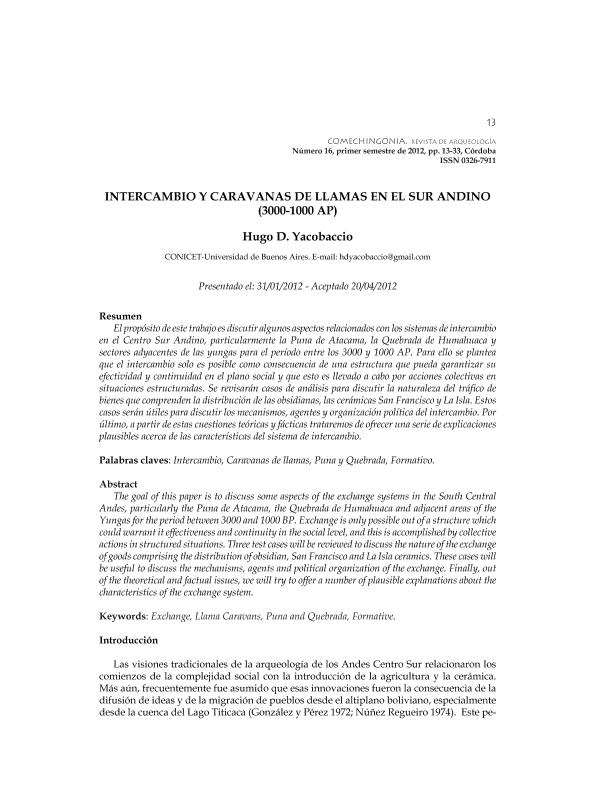Mostrar el registro sencillo del ítem
dc.contributor.author
Yacobaccio, Hugo Daniel

dc.date.available
2023-04-25T18:20:30Z
dc.date.issued
2012-04
dc.identifier.citation
Yacobaccio, Hugo Daniel; Intercambio y caravanas de llamas en el sur andino (3000-1000 AP); Centro de Estudios Históricos Prof. Carlos S. A. Segreti; Comechingonia; 16; 1; 4-2012; 9-29
dc.identifier.issn
0326-7911
dc.identifier.uri
http://hdl.handle.net/11336/195321
dc.description.abstract
El propósito de este trabajo es discutir algunos aspectos relacionados con los sistemas de intercambio en el Centro Sur Andino, particularmente la Puna de Atacama, la Quebrada de Humahuaca y sectores adyacentes de las yungas para el período entre los 3000 y 1000 AP. Para ello se plantea que el intercambio solo es posible como consecuencia de una estructura que pueda garantizar su efectividad y continuidad en el plano social y que esto es llevado a cabo por acciones colectivas en situaciones estructuradas. Se revisarán casos de análisis para discutir la naturaleza del tráfi co de bienes que comprenden la distribución de las obsidianas, las cerámicas San Francisco y La Isla. Estos casos serán útiles para discutir los mecanismos, agentes y organización política del intercambio. Por último, a partir de estas cuestiones teóricas y fácticas trataremos de ofrecer una serie de explicaciones plausibles acerca de las características del sistema de intercambio.
dc.description.abstract
The goal of this paper is to discuss some aspects of the exchange systems in the South Central Andes, particularly the Puna de Atacama, the Quebrada de Humahuaca and adjacent areas of the Yungas for the period between 3000 and 1000 BP. Exchange is only possible out of a structure which could warrant it effectiveness and continuity in the social level, and this is accomplished by collective actions in structured situations. Three test cases will be reviewed to discuss the nature of the exchange of goods comprising the distribution of obsidian, San Francisco and La Isla ceramics. These cases will be useful to discuss the mechanisms, agents and political organization of the exchange. Finally, out of the theoretical and factual issues, we will try to offer a number of plausible explanations about the characteristics of the exchange system.
dc.format
application/pdf
dc.language.iso
spa
dc.publisher
Centro de Estudios Históricos Prof. Carlos S. A. Segreti
dc.rights
info:eu-repo/semantics/openAccess
dc.rights.uri
https://creativecommons.org/licenses/by-nc-sa/2.5/ar/
dc.subject
Intercambio
dc.subject
Caravanas de llamas
dc.subject
Puna y Quebrada
dc.subject
Formativo
dc.subject.classification
Arqueología

dc.subject.classification
Historia y Arqueología

dc.subject.classification
HUMANIDADES

dc.title
Intercambio y caravanas de llamas en el sur andino (3000-1000 AP)
dc.type
info:eu-repo/semantics/article
dc.type
info:ar-repo/semantics/artículo
dc.type
info:eu-repo/semantics/publishedVersion
dc.date.updated
2023-04-25T11:50:27Z
dc.journal.volume
16
dc.journal.number
1
dc.journal.pagination
9-29
dc.journal.pais
Argentina

dc.journal.ciudad
Córdoba
dc.description.fil
Fil: Yacobaccio, Hugo Daniel. Universidad de Buenos Aires. Facultad de Filosofía y Letras. Instituto de Arqueología; Argentina. Consejo Nacional de Investigaciones Científicas y Técnicas; Argentina
dc.journal.title
Comechingonia
dc.relation.alternativeid
info:eu-repo/semantics/altIdentifier/url/https://revistas.unc.edu.ar/index.php/comechingonia/article/view/17960
Archivos asociados
